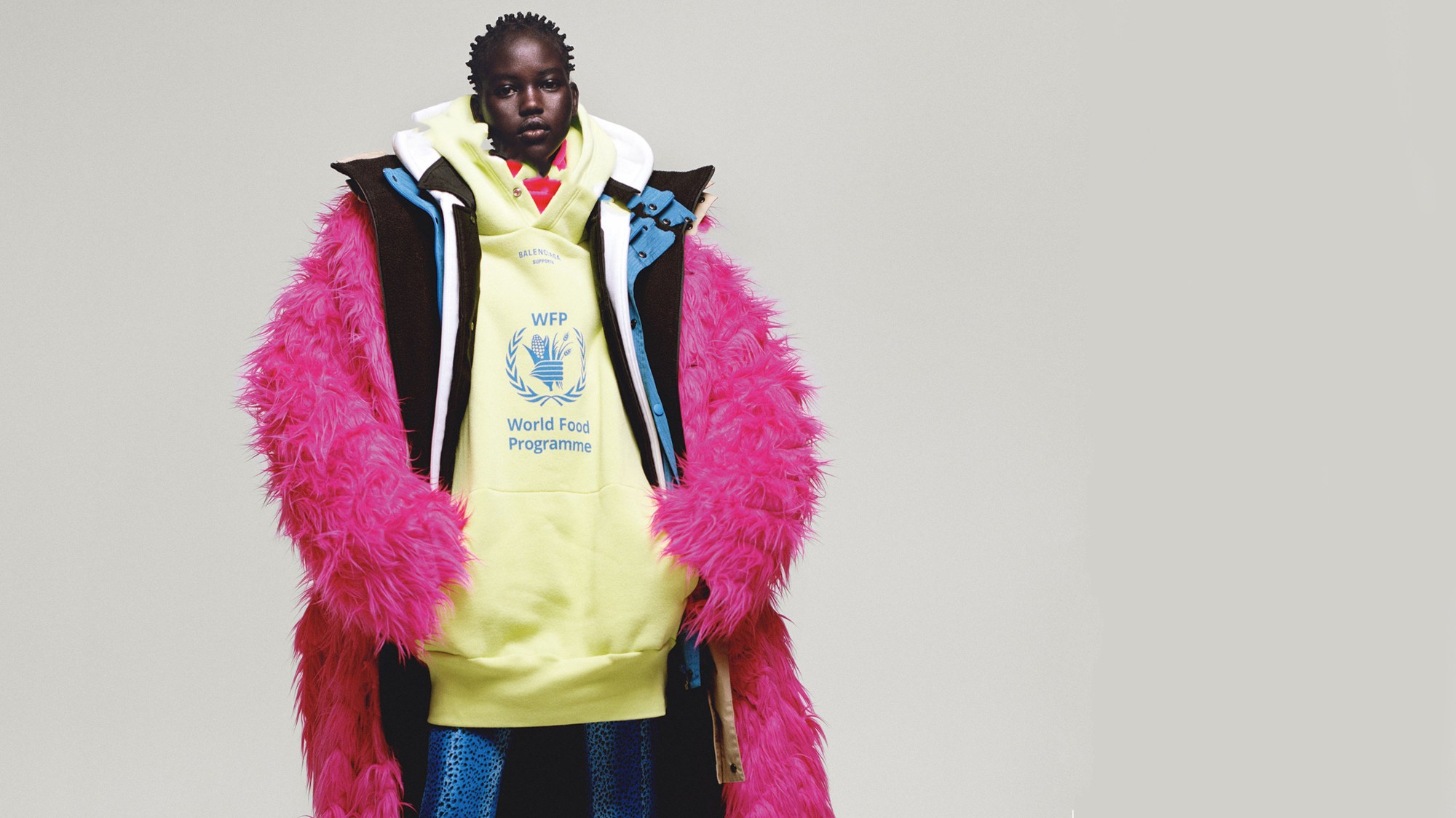This article originally appeared in i-D’s The Earthwise Issue, no. 353, Fall 2018.
Demna Gvasalia hasn’t returned to his hometown of Sukhumi, the capital of Abkhazia, Georgia, since 1993. “I can’t actually,” he says, “even now. It would be dangerous for me to go with my family name.” The world’s most in demand designer was just 12 years old when he and his family were forced to flee their home to escape ethnic cleansing by Abkhaz separatists, after the fall of the Soviet Union. Demna’s story is inconceivable for most of us living and working in the western world, yet it shapes everything he does, including this season’s Balenciaga collaboration with The World Food Programme across a series of WFP logo’d T-shirts, hoodies, bum bags and shirts.
The World Food Programme is an organisation close to Demna’s heart. Throughout our conversation, he talks about it passionately and fast. (“What is time,” he says when I thank him for giving up his, “this is more important”). In the two short years since he was appointed Creative Director of Balenciaga, Demna has created a lifestyle, a world, with legions of fans – 6.8 million on Instagram at the time of going to print. The 101-year-old luxury house is a mecca for cool kids looking for cool clothes, and the fastest-growing label in the Kering Group. It is a sign of the times, that Demna should use his position at the helm to raise awareness for something outside of fashion. “It came about from an honest desire to do something that stood for something,” he says over coffee at Balenciaga’s Paris headquarters. Dressed in his trademark baseball cap, T-shirt and baggy jeans, he’s the antithesis of French fashion. “When we first approached The World Food Programme they were a bit suspicious,” he continues, “but they want to do anything that makes a difference. I love the fact that they went with it.”

With one in nine people in the world still going hungry, the food-assistance branch of the United Nations is the largest humanitarian organisation in the world working to alleviate hunger. Assisting 80 million people, in 80 countries, it offers vital food aid in emergencies and works on the ground with communities to help break the cycle of hunger and poverty.
The collection of hoodies, T-shirts, bum bags and baseball hats that appeared in Balenciaga’s autumn/winter 18 collection come in fluro yellow and black, emblazoned with the WFP logo of a fist clutching a sheaf of corn together with the slogan ‘Changing lives, saving lives’. “It was a real collaboration,” Demna continues, with the WFP involved across all aspects of design, from garment colour to logo placement.
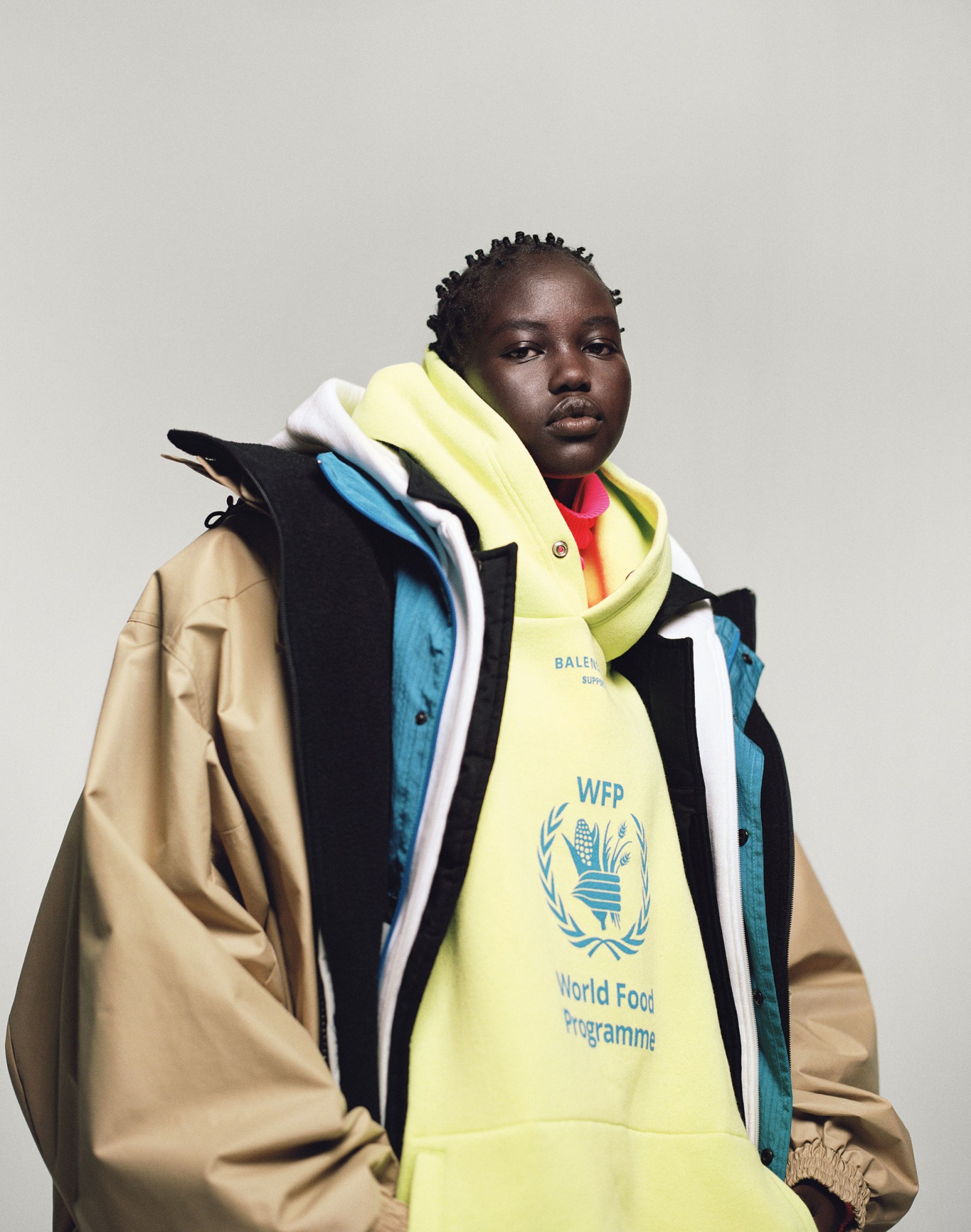
Born out of an honest desire to do something bigger than fashion, the collaboration turned out to have greater personal significance for Demna than he first thought. “Funnily enough, I only discovered this when I told my dad,” Demna says. “He said to me, ‘but this is the company who supplied aid to refugees in separatist Georgia after the war!” Convinced it was too much of a coincidence to be true, Demna did his own research, and was surprised to discover that his dad was right. The World Food Programme did indeed supply aid to the Gvasalia family and other refugees when they fled across the Caucasus mountains to escape the brutal civil war that broke out against the Georgian government.
“The World Food Programme fed me when I was 12 and had no place to live,” he says. “They brought bread, grain… and they delivered it via helicopters to the middle of the mountain. My whole story sounds like a Hollywood tale, but it was real, it was a real thing.” The fact that he unknowingly partnered with the same organisation 25 years later is one of life’s great twists of fate. “Fashion doesn’t need to be superficial,” he says. “Product can communicate. It’s my personal belief that the future of brands will be based on social involvement. Otherwise there is no survival.”
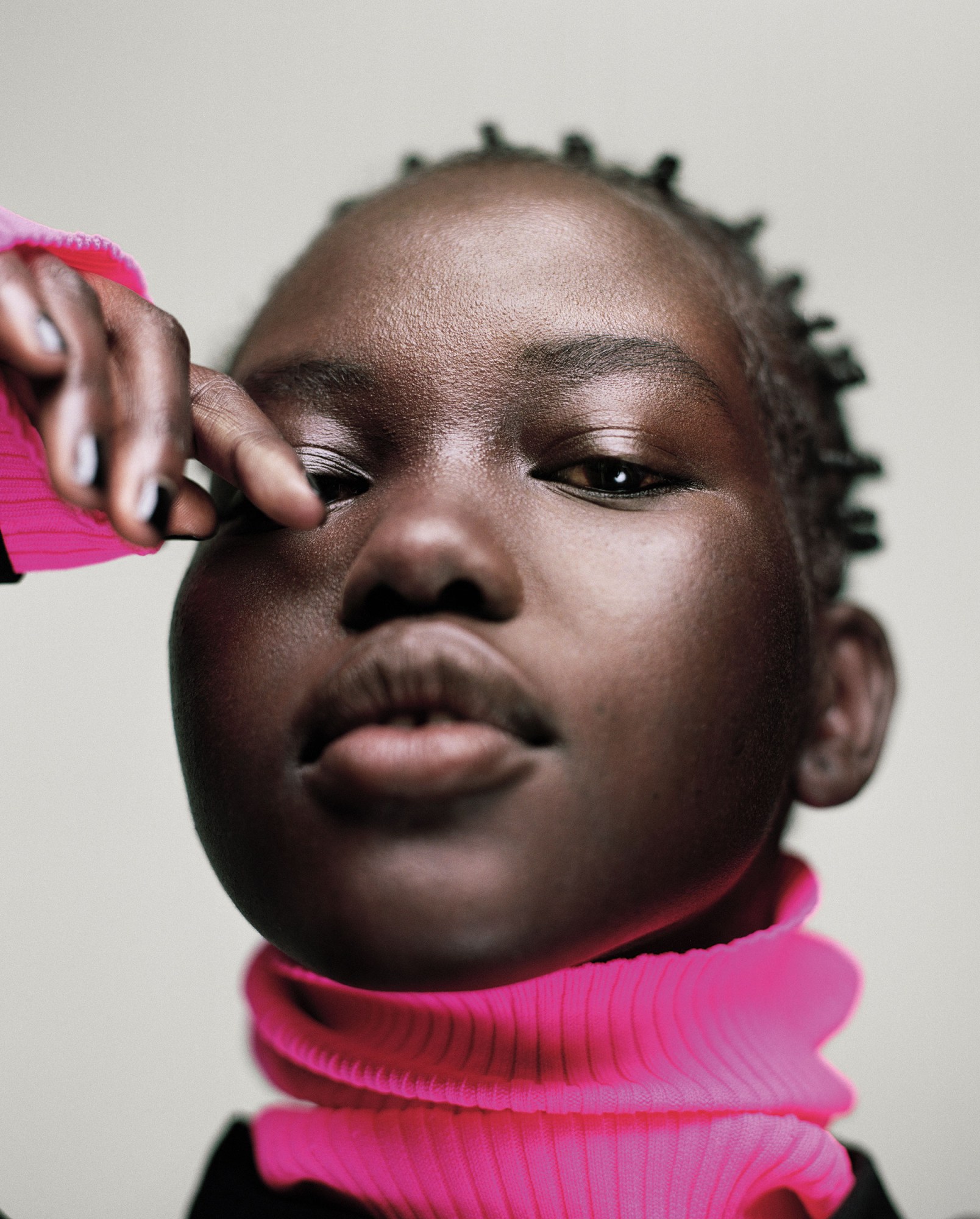
Set against a giant snow mountain, scrawled with graffiti messages that read ‘think big’, ‘the power of dreams’, ‘no borders’ and ‘you are the world’, the autumn/winter 18 Balenciaga show was a powerful and poignant new direction for Demna, and the first time he introduced a set to his work. “All the shows we’ve done before were just about the clothes. And that’s it,” he explains. “The atmosphere was brought by the music, the way people walked, the cast… I think that neutrality was important for me to discover my creative vision, but this season I wanted to be theatrical and do more storytelling. I wanted it to be an experience people would remember.”
Reminiscent of late artist Leonard Knight’s Salvation Mountain nestled in the Californian desert, Demna’s mountain of messages was both awesome and inspiring. “There was a lot of colour and hope,” he says of the 74-look collection that saw menswear and womenswear combine for the first time. There were draped velvet mini dresses, 3D floral prints, ‘Speedhunter’ band merch and fluro polo necks with arms that stretched out into gloves over the hands. But the real stars of the show were the jackets.
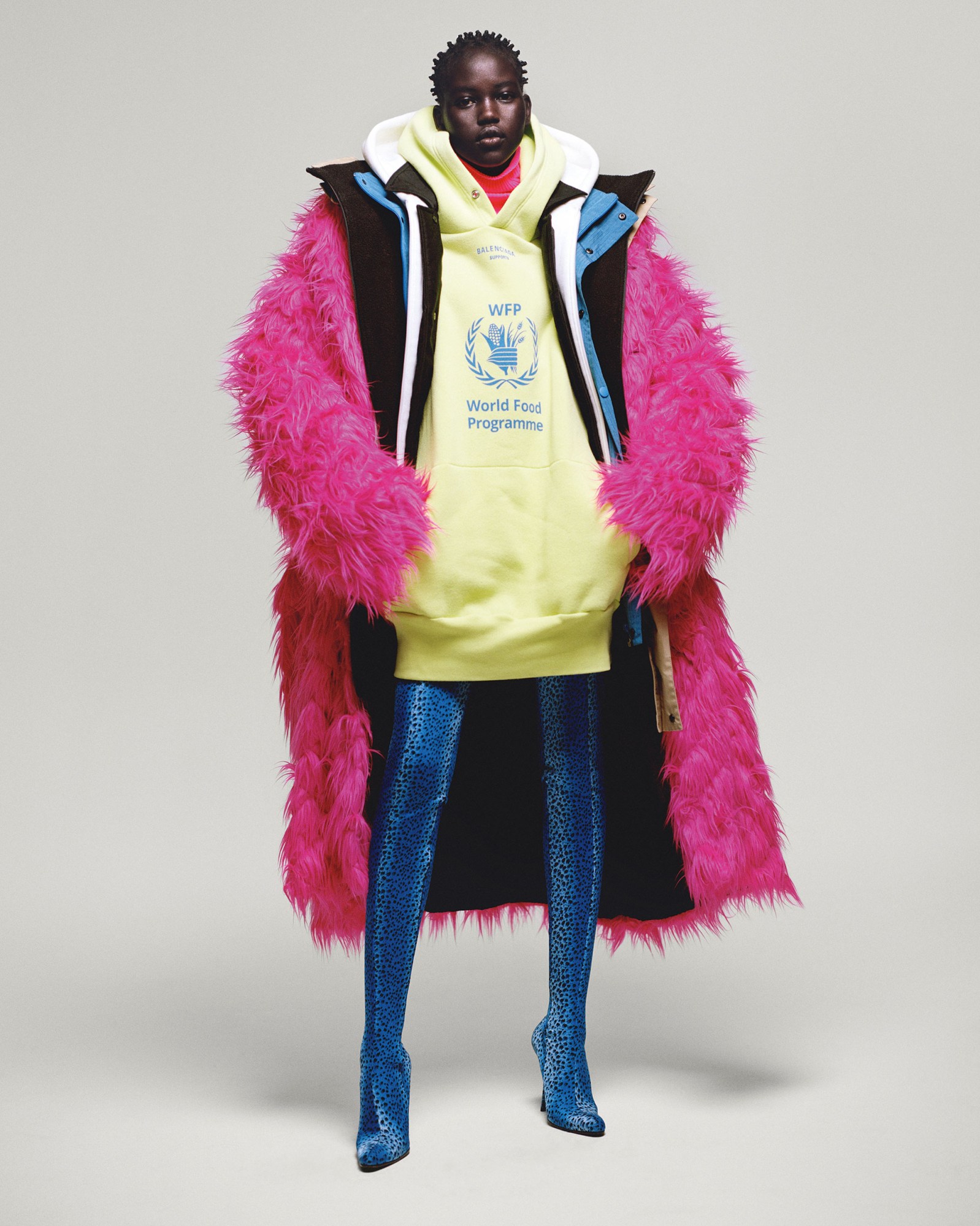
In a technical first, Demna worked with 3D body scanners on digital fittings to reimagine the cocoon like shapes of Cristóbal Balenciaga for a future generation. Bonding wool, tweed and velvet to lightweight foam, these sculptural creations came with nipped in waists and exaggerated, padded hips.
“It was the first time that I worked on a laptop,” Demna told journalists after the show. “After 3D scanning bodies, we 3D printed them on to moulds. There were only two seams, no construction and one layer of fabric.” As the collection evolved, these jackets gave way to oversized denim and giant raincoats and parkas worn over World Food Programme branded T-shirts, hoodies, bum bags and shirts. “We styled the models almost like the volunteers who ask you to sign petitions for Greenpeace, or whatever, on the streets,” Demna explained, choosing the youngest girls and boys in the line up to model the World Food Programme pieces, “so it looked like it was the youth giving this message.”
“I didn’t know it, but the World Food Programme fed me when I was 12 and had no place to live. They brought bread, grain… and they delivered it via helicopters to the middle of the mountain. My whole story sounds like a Hollywood tale, but it was real, it was a real thing.” Demna Gvasalia
While charity merchandise is no new concept, charity and luxury can still be difficult bedfellows. Was Demna worried that the World Food Programme collaboration could be interpreted as gimmicky? “Two years ago, I would have been worried,” he says. “But I’ve changed a lot since then. Deep in my gut I knew that it was the right thing to do, because I know how sincere this project is. It’s really personal, and these things have to be personal, they can’t be linked to a strategy or a brand.” True to his word, Balenciaga donated $250,000 to the World Food Programme on the day of the show, and 10% of all sales from each WFP branded product sold in Balenciaga stores and online will go towards the organisation too. “It’s really important that this makes a change,” Demna stresses. “This isn’t just about making a printed T-shirt. It’s part of my vision and part of who I am.”
Last year, the hard living and hard partying designer stunned the industry, and friends alike, when he decided to swap the bright lights of Paris for the leafy tranquillity of Zurich. Today he splits his time between both cities; spending three weeks in Zurich and one week in Paris, made possible by Balenciaga setting up a studio for him in the Swiss capital and the Balenciaga design team travelling back and forth. “It’s a new me,” Demna says with a smile. “The move has helped me understand what fashion means to me today, what it is at Balenciaga and how I see it at Vetements… The nightclubs and scary messages on T-shirts, with shoulder pads, are never going to go out of my vocabulary, but today there are other things that interest me too. I want to move on. I want to do new things.”

While Demna may have found a new sense of place, his own experiences of migration and displacement as a child still infiltrate his work across both brands. “My recent show at Vetements was all about migration,” he says, of the brand’s spring/summer 19 collection staged under a flyover in Porte de la Villette in Paris this June. “We live it in Europe now. You see it on the streets. It’s the subject on everybody’s lips…” The collection explored emblems from his own war-torn childhood, from military-inspired sportswear to Georgian flags, target print T-shirts complete with bullet holes and zipped up bondage masks symbolising the erasing of identity that he experienced as a young boy. “Not many people know about the particular war where I come from,” he says, “but it was war. It doesn’t matter where you are. Nothing really changes. You lose your home. The concept is the same. There is no winner in the end.”
A new politicised mood has swept across fashion this season, with a host of designers standing up and speaking out to promote change. Gucci donated $500,000 to the March for Our Lives rally for gun control, Burberry debuted a new rainbow check in support of LGBTQ+ charities, Raf Simons supported those in recovery from addiction, Lacoste raised awareness for animals facing extinction and Dior shone a light on the pro-feminist riots of 60s Paris, to name a small few. Does it mark a shift in fashion towards greater social, political and environmental awareness? “I believe so, I hope so,” Demna says. “I’m a transcendent optimist, and a lot of people I talk to, and work with, share the same ideas and values as I do.” Alongside Alessandro Michele at Gucci, Virgil Abloh at Louis Vuitton and Kim Jones at Dior, the 36-year-old is spearheading a new wave of designers redefining what fashion can and should stand for in 2018. “Things are happy. Good things are happening. I’m very positive,” Demna says of this new generation. “I always search for an understanding of what fashion is going to be like in five years. In ten years. And I think it’s going to be good. There are good values there.”
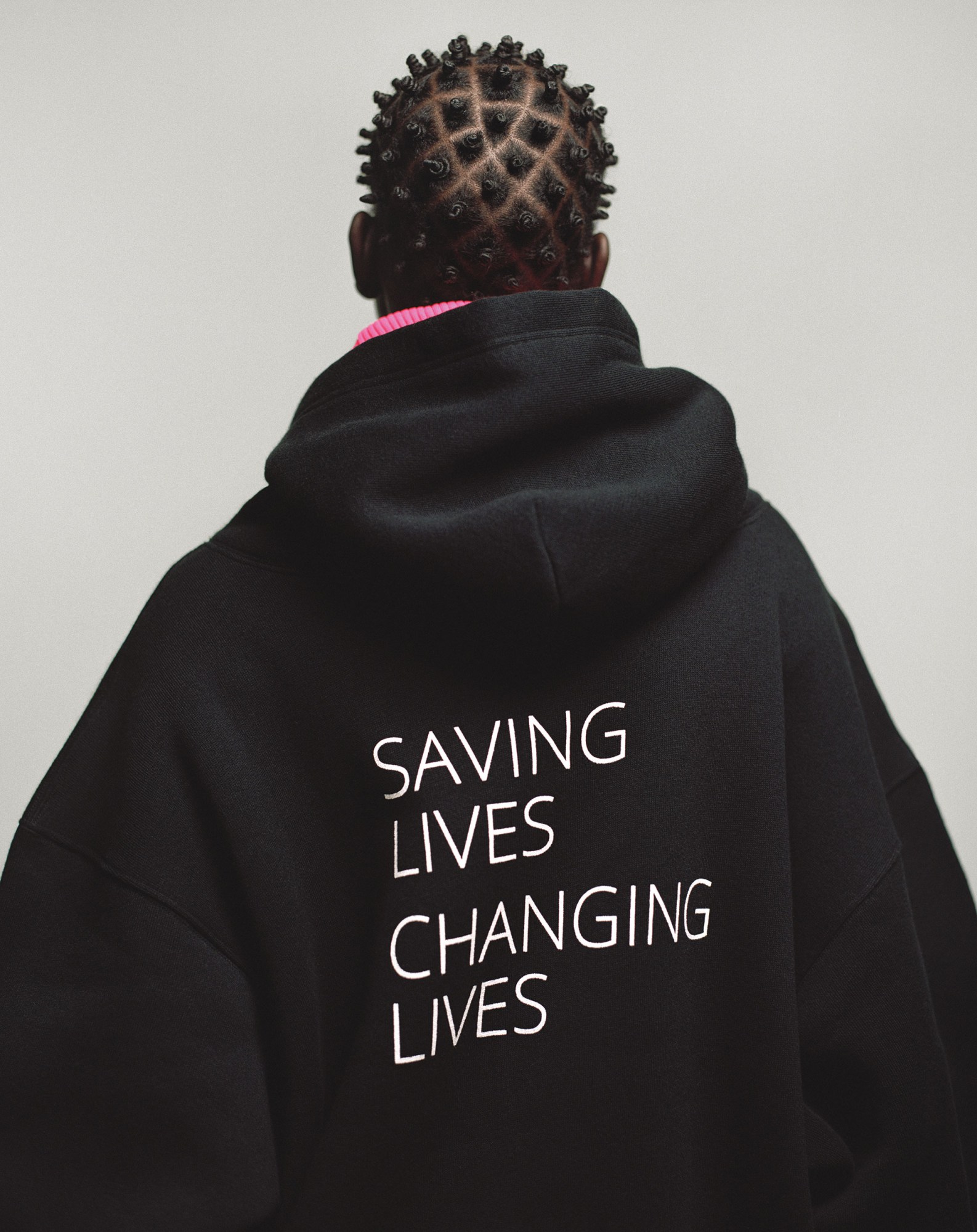
It is young consumers who are driving this shift in attitude. Gen Z stand for something, and they want their brands to stand for something too. “It’s like the end of the 60s, in a modern way,” Demna agrees. “Change is happening, even though we don’t realise it, because everything is done online. We don’t have to go out on the streets and wear flowers anymore.” While clicktivism has its place, it takes more to create real change and Demna hopes to inspire people to do this through his clothes. “Sitting at home being angry about things is very 2017 in a way,” he says. “It’s too easy. It doesn’t work. Whenever we can do more than just give an opinion on social media, we must. I believe in action. Whether it’s big or small, everything counts.”
Authenticity and sincerity define this new chapter for Demna. “From now on, every product I put out really has to represent both my aesthetic values and my ethical values as well,” he concludes. Aesthetics and ethics – if that isn’t the future of fashion, then we don’t know what is.

Credits
Photography Campbell Addy
Fashion director Alastair McKimm
Hair Duffy at Streeters. Make-up Hannah Murray at Art + Commerce using SK11. Nail technician Tracylee at The Wall Group using Chanel Le Vernis. Photography assistance William Takahashi and Jamie Ellington. Styling assistance Madison Matusich and Maggie Holladay. Hair assistance Lukas Tralmer. Make-up assistance Jamie Stehlin. Production Mary Clancey Pace. Casting director Samuel Ellis Scheinman for DMCasting. Model Adut Akech at The Society.
Adut wears all clothing Balenciaga.
